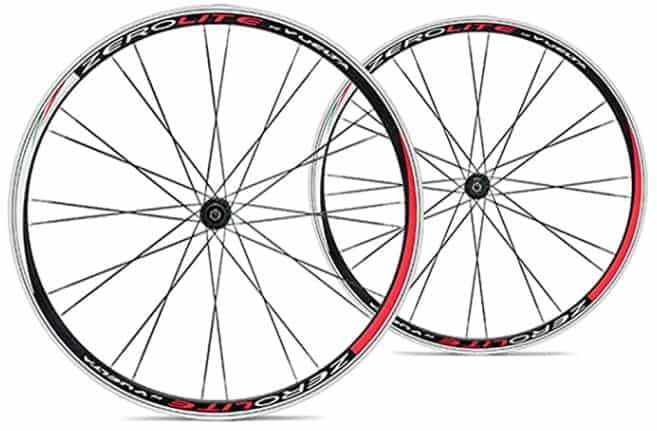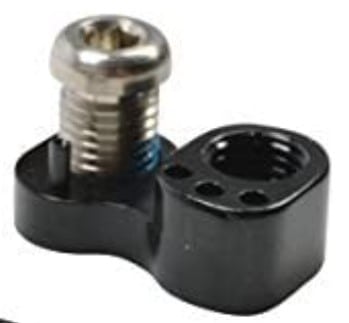A mountain bike is primarily built to tackle rugged bike trails. As a result, the bike’s geometry and wheels provide the best ride quality on the hilly dirt paths. But can you put 700c wheels on a 26 bike when you have to ride your mountain bike on the roads?
You can put 700c wheels on mountain bikes designed for 26-inch MTB wheels though you will have a limited tire choice. These bikes offer the smallest clearance, and their fork arches and chainstay bridges can only accept 700c wheels that are not so big.
Specifically, a 26-inch MTB can accept 700c tires that are about 23-25mm wide. This happens to be the typical size meant for road bike tires.

Can You Put 700c Wheels On A 26 Bike – What’s The Difference?
Before going deep, it is prudent to differentiate between 700c and 26-inch MTB wheels. Generally, mountain bike wheels are smaller, broader, and sturdier than road bike wheels.
Also, these wheels are meant to run on low air pressure to help with absorbing shocks from the trails. In addition, the low pressure allows the wheels to get over obstacles with lots of ease.
Unfortunately, these features that make an MTB so effective on the trails are disadvantageous on the road.
First, the bike feels a bit too slow in acceleration due to the wide tires under low air pressure. Secondly, the tires designed for trail wear out fast on the roads and paved surfaces.
On the other hand, 700c road bike wheels have a bigger total diameter, and they are narrower than wheels found on a typical 26-inch mountain bike.
Notably, there are 700c wheels for 29er mountain bikes such as the Queen Bike Carbon Fiber Road Bike Wheels (View on Amazon) which are a bit wider than the road bike wheels. All the same, you can put the wheels on a 26 bike so long as they are not too big for your frame.
So, 700c road tires happen to be sleeker and bigger in diameter. In addition, they have better acceleration on the tarmac, and since these tires are meant for asphalt, they are slower in wearing out.
Can You Put 700c Tires On 26 Inch Rims?
Anything that would make the transition 700c wheels cheaper could come as a great relief. Actually, it isn’t wrong to imagine whether you can put 700c tires on 26-inch rims.
Well, the two are not compatible, and therefore, you can’t use a 700c tire on a 26-inch rim.
Mostly, the 26-inch tires will have a width of 1.75”-2.2”. However, it is possible to find 26-inch tires that are 1” up to 1.5” wide.
Most importantly, a standard 26” tire has a BSD of 559mm. In addition, the outer diameter of a 26-inch wheel is approximately 670mm, which is 26.2 inches, thus the name.
On the other hand, the 700c tires happen to be a bit bigger in diameter. Actually, the wheels have an outside diameter of 700mm and a BSD of about 630mm on average.
Basically, a 700c tire’s BSD (which is the most important determinant when installing a tire on a rim) is 71mm wider than a 26” rim. As a result, you can’t use a 700c tire on a26 inch rim.

26-Inch To 700c Wheel Conversion – What It Entails
Converting a 26” bike to a 700c wheel sounds much easier than it really is. Actually, it entails more than getting a new rim and a new tire. The process will affect other systems on the bike, and therefore, you will also need to work on them.
Different Rear Hub O.L.D
Generally, most mountain and road bikes use front hubs with 100mm over-locknut dimension, which is the exterior distance between the hub’s locknuts.
On the other hand, the rear hubs for these bikes are different. On average, road bikes that use caliper brakes have an O.L.D. of 130mm, while mountain bikes have an O.L.D. of 135mm.
Notably, newer road bikes wheels that use disc brakes have an O.L.D. of 135mm.
Thus, a typical 700c wheel’s rear hub will be 5mm narrower than the chainstays of a 26” bike.
For more straightforward conversion, you can use the hacks we discussed in the article “Can I put 700c wheels on a mountain bike?”
Alternatively, get a rear hub such as the KOOZER Bicycle Hub (View on Amazon) that has an O.L.D. of 135mm. it is made of aluminum alloys and has sealed bearings.
Rim Brakes Needs Modification
Notably, as we had discussed earlier, a 700c wheel will have a wider diameter than that of a 26” bike. Therefore, if your 26” bike uses rim brakes, the default braking system will become useless.
Specifically, if you put 700c wheels on a 26 bike, the rim’s braking surface will go above the brake pads by over 1-inch.
Therefore, you will need v-brake boss extenders such as the BOX COMPONENTS brake post extenders that will provide new mounting positions above the original holes.
All the same, disc brakes make the conversion to the 700c wheel much easier. Therefore, so long as the new wheelset has rotors compatible with the calipers you have, the process shouldn’t make you break a sweat.

Limitations Of Putting 700c Wheels On A 26 Bike
1. It could be too costly
If your 26” bike uses rim brakes, then the conversion process to 700c could get overwhelmingly expensive. This is because you have to buy new rims, new tires, inner tubes, and v- brake extenders.
Also, if the rear hubs’ O.L.Ds. don’t match, you will have to invest in a new hub or extra labor to adjust the frame and the drive train.
Therefore, the conversion may not make much financial sense
2. Limited Tire Options
Remember, the 26” wheel is shorter in diameter than the 700c. Therefore, 26” bikes, especially the MTBs, have the smallest wheel clearance. In that case, installing wider wheels on a frame designed for smaller wheels can be challenging.
Mainly, the forks’ arch and the chainstays’ bridge are the most limiting areas.
A typical 26” MTB wheel has an average outer circumference of 2048.4mm. On the other hand, a 700c×25 wheel has a circumference of 2105.mm. This is more than what is recommended for a 26” bike frame.
Table 1: 26” tire sizes
| Tire Size | Circumference in M | Circumference in mm |
| 26″ x 1.25″ | 1.95 | 1950 |
| 26″ x 1.40″ | 2.005 | 2005 |
| 26″ x 1.50″ | 2.01 | 2010 |
| 26″ x 1.75″ | 2.023 | 2023 |
| 26″ x 1.95″ | 2.05 | 2050 |
| 26″ x 2.00″ | 2.055 | 2055 |
| 26″ x 2.1″ | 2.068 | 2068 |
| 26″ x 2.125″ | 2.07 | 2070 |
| 26″ x 2.35″ | 2.083 | 2083 |
| 26″ x 3.00″ | 2.17 | 2170 |
Table 2: 700c tire sizes
| Tire Size | Circumference in M | Circumference in mm |
| 700 x 19C | 2.08 | 2080 |
| 700 x 20C | 2.086 | 2086 |
| 700 x 23C | 2.096 | 2096 |
| 700 x 25C | 2.105 | 2105 |
| 700 x 28C | 2.136 | 2136 |
| 700 x 30C | 2.146 | 2146 |
| 700 x 32C | 2.155 | 2155 |
| 700 x 35C | 2.168 | 2168 |
| 700 x 38C | 2.18 | 2180 |
| 700 x 40C | 2.2 | 2200 |
From the tables above, it is clear that converting a 26” to 700c will leave you with fewer tire options.
3. Higher Chances Of Toe Overlap
Since the 700c wheel is wider than the 26” tire, you will likely knock your toes on the front wheel during tight turns.
Primarily, this will affect bikes with small frames, such as mountain bikes.
Unfortunately, toe overlaps may be catastrophic, especially when riding downhill. In that case, you need to choose your wheels keenly and take time to get used to the big wheels.
Final Take: ”Can you put 700c wheels on a 26 bike?”
In conclusion, when riding a bicycle, you ride on the frame but roll on the wheels. So, can you put 700c wheels on a 26 bike without adversely affecting your ride’s quality?
Yes, you can install 700c wheels, but if your bike uses rim brakes, you will have to modify the braking system.
Also, you will need to use washers for hubs with O.L.D of less than 135mm or get a new hub altogether.
All the same, changing to 700c wheels will leave you with fewer tire options for your bike. All the same, the conversion is a possible hack.
Frequently Asked Questions
How much larger is a 700c compared to a 26?
The difference in diameter between these two rim sizes may appear minor, but it’s significant. Contrary to the common mistaken belief that a 700c rim is smaller than a 27″ rim, a 700c rim is actually about 2.5 inches larger than a 26″ rim. That’s a sizeable difference in the world of rims and tires. Imagine speaking in golf terms, it’s like the difference between hitting the green or ending up in the bunker. That’s important.
Is it possible to install 700c wheels on my mountain bike?
Imagine trying to fit an elephant under a bridge. You may succeed, but is it safe or reasonable? Similar analogy applies here. While technically you might be able to fit larger wheels on a bike designed for smaller ones, we strongly advise against it. The deviation from the original, manufacturer-specified wheel size could cause clearance issues, pose risks to rider safety, and even displease the bike’s aesthetics. In my past mountain biking experience, any non-standard modification could spell the difference between a delightful ride and a potential mishap.
Can I change my bike’s wheel size?
As an expert cyclist with years of biking under my belt, I can tell you it’s technically achievable. However, going from my personal experience and the collective wisdom of many seasoned riders I’ve interacted with, it’s not recommended. Bikes are precision-engineered with designated wheel sizes for good reasons — balance, control, and, above all, rider safety. A shift in wheel size could upset these parameters, risking clearance issues and jeopardizing your safety. So while it’s possible, it trenches on the “not advisable” side of things.
Which tire sizes fit 26 inch rims?
When it comes to fitting 26-inch tires, think of it like an expansive beach with room for both lean joggers and robust beachgoers. Usually, a 26″ tire can accommodate widths running from a slim 1.5″ to a broad 2.3″ or even wider, with the core determining factor being the fork width/height. My personal leanings toward street riding led me to prefer skinnier tires – it gives you that extra zip and agility when maneuvering through city traffic. But whatever your preference, 26 inches is a versatile size that leaves considerable room for options.